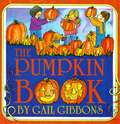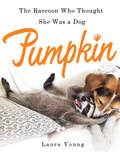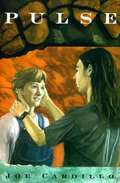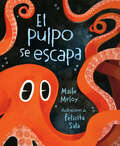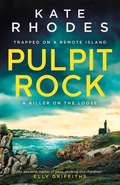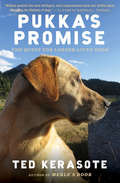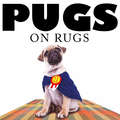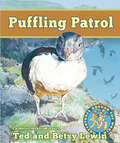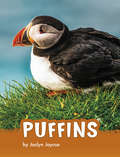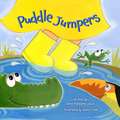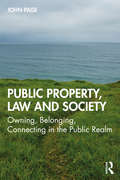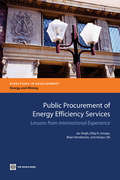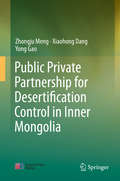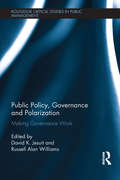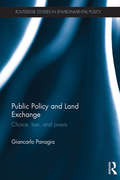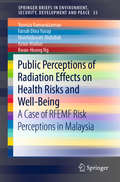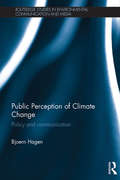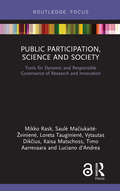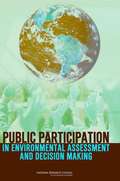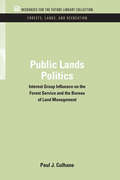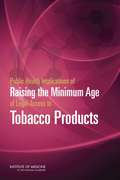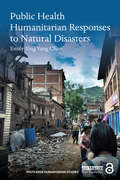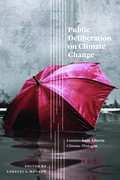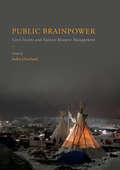- Table View
- List View
The Pumpkin Book
by Gail GibbonsDescribes how pumpkins come in different shapes and sizes how they grow and their traditional uses and cultural significance Includes instructions for carving a pumpkin and drying the seeds Gail Gibbons is the well known nonfiction author for children. Other titles include Fire Fire, Apples, Bats, and the Post Office. This book would be a wonderful teaching tool with real pumpkins.
Pumpkin: The Raccoon Who Thought She Was a Dog
by Laura L. YoungAs a baby, Pumpkin the Raccoon was abandoned by her parents after falling out of a tree and breaking her leg. Taken in by a family with two rescue dogs, Toffee and Oreo, Pumpkin gained a new set of "parents" and a life of luxury in the Bahamas.Pumpkin: The Raccoon Who Thought She Was a Dog is a sweet, unique look at an adorable household pet, captured in gorgeous, never-before-seen photographs in luxurious settings. Pumpkin's message is that friendship and love can be found in the most unlikely of companions. With a lot of personality, and a little bit of mischief, Pumpkin will capture hearts all around the world.
Pulse
by Joe CardilloJuniors in high school and very much in love, Jason and his girlfriend, Kris, feel in sync with the beat of the universe. Then word gets out that the local planning board wants to turn their favorite outdoor retreat into a shopping mall. To fight back, the outraged couple organizes a student environmental group called Pulse. With a mission to save the Pinehaven wilderness area, Pulse embarks on a battle against city hall. But soon Jason and Kris discover a web of local corruption more tangled than they ever suspected. Everyone appears to be in it for the Almighty Dollar--even Kris's mom, who wants to move her flower shop to the new mall. When a crew of punk kids at school decides that they're personally going to stop the Pulse activists, just for kicks, Jason and Kris resolve to lay everything on the line. What they don't know is that it may cost a life. Using a contemporary, stream-of- consciousness voice that hums with authenticity, Joe Cardillo weaves a lyric and involving love story for our time.
El pulpo se escapa
by Maile MeloyDe una autora best seller del New York Times surge este conmovedor y lírico relato sobre el gran artista del escape en la naturaleza, perfecto para los fanáticos del documental ganador del Oscar My Octopus Teacher. El pulpo vivía feliz en su cueva submarina hasta que un día, un buzo lo captura y lo lleva a vivir a un acuario. Los humanos le dan comida y le ponen pruebas que parecen juguetes. Pero todos los días son iguales, y el pulpo pronto se cansa de la vida cautiva. Y así, al amparo de la oscuridad, emprende un escape audaz. Maile Meloy y Felicita Sala nos traen una historia llena de emoción y sentimiento, sobre la exaltación de conquistar la libertad con tanto esfuerzo y el llamado del hogar.
Pulpit Rock: The Isles of Scilly Mysteries: 4
by Kate RhodesTHE ISLES OF SCILLY MYSTERIES #4 &‘Clever, atmospheric and compelling, it&’s another masterclass in plotting&’ WOMAN'S WEEKLY 'Rhodes is a published poet and every one of her sentences sings' FINANCIAL TIMESWITH A KILLER ON THE LOOSE As the scorching summer sun beats down on St Mary&’s in the Isles of Scilly, DI Ben Kitto and his team are training for the annual Swimathon, until they discover a body hanging from Pulpit Rock, dressed in a bridal gown.ON A TINY ISLAND An obsessive killer is hunting for female victims. Kitto has no choice but to stop anyone leaving St Mary&’s, but soon another woman is attacked.EVERYONE IS A SUSPECT The killer must be a trusted member of the community. Kitto&’s investigation is being watched closely, the killer always one step ahead, as the next victim is chosen . . .NO ONE IS SAFE PRAISE FOR KATE RHODES: &‘Gripping, clever and impossible to put down. I&’ve been a Kate Rhodes fan for years and in Ben Kitto she has created a detective who is just as complex and compelling as Kate&’s elegant plotting and stunning prose. The claustrophobia and paranoia of the island are so brilliant evoked, I could almost feel the tide encroaching as time ran out to find the killer' ERIN KELLY &‘Absorbing and complex, Hell Bay kept me guessing until the final pages&’ RACHEL ABBOTT 'A vividly realised protagonist whose complex and harrowing history rivals the central crime storyline' SOPHIE HANNAH 'Beautifully written and expertly plotted; this is a masterclass' GUARDIAN 'Expertly weaves a sense of place and character into a tense and intriguing story' METRO 'Rhodes does a superb job of balancing a portrayal of a tiny community oppressed by secrets with an uplifting evocation of setting' Jake Kerridge, SUNDAY EXPRESS &‘The whole book tingles with tension. I hope it does for the Scilly Isles what Ann Cleeves did for Shetland' MEL MCGRATH 'I love reading Kate's books in the way I love reading Sophie Hannah – a poet writing crime fiction is a great thing . . . It is at once a locked-room mystery, a story of the returning hero, and an examination of fear and abuse. It has the air of a twenty-first century Agatha Christie' JULIA CROUCH
Pukka's Promise: The Quest for Longer-Lived Dogs
by Ted KerasoteThis guide by the author of Merle&’s Door is &“beneficial for anyone who wants to ensure that their dogs will be healthy and well&” (Seattle Post-Intelligencer). From the bestselling author who offers &“the most utterly compelling translation of dog to human I have ever seen&” (Jeffrey Masson), this is a joyful chronicle of a dog and a groundbreaking answer to the question: How can we give our dogs the happiest, healthiest lives? When Ted Kerasote was ready for a new dog after losing his beloved Merle—who died too soon, as all our dogs do—he knew he wanted to give his puppy Pukka the longest life possible. But how to do that? So much has changed in the way we feed, vaccinate, train, and live with our dogs from even a decade ago. In an adventure that echoes The Omnivore&’s Dilemma with a canine spin, Kerasote tackles these subjects, questioning our conventional wisdom and emerging with vital new information that will surprise even the most knowledgeable dog lovers. Can a purebred be as healthy as a mixed breed? How many vaccines are too many? Should we rethink spaying and neutering? Is raw food really healthier than kibble, and should your dog be chewing more bones? Traveling the world and interviewing breeders, veterinarians, and leaders of the animal-welfare movement, Kerasote pulls together the latest research to help us rethink the everyday choices we make for our companions. And as he did in Merle&’s Door, Kerasote interweaves fascinating science with the charming stories of raising Pukka among his dog friends in their small Wyoming village. Funny, revelatory, and full of the delights of falling in love with a dog, Pukka&’s Promise will help redefine the potential of our animal partners.
Pugs on Rugs
by Jack RussellWhat is it that makes pugs so lovable? Is it their doleful eyes? Their down-turned mouths? Furrowed brows? While they may look sad, they’ve certainly found their place in our homes and our hearts. Now the adorable creatures have a new home, sitting on rugs in 43 amusing photographs! What could be cuter?Pugs on Rugs celebrates different pugs on different rugs. The dog might be walking, sitting, or sleeping and the rug could be Persian, Aztec, or oriental, but the image is guaranteed to be cute and funny!People have been obsessed with pugs for centuries and each of this small book’s spreads features a photograph (or montage) alongside an amusing caption and a fascinating fact about the history and characteristics of this unique breed.Did you know that the first pugs were brought from China to Europe to serve as guard dogs? Or that a famous pug named Pompey once saved a Dutch prince from assassination? Have you heard about the eighteenth-century German secret society dedicated to the pug in which new members initiated themselves by wearing a collar, scratching at the door, and kissing the rear end of a giant porcelain pug? Yes indeed, pug lovers are an interesting breed and this volume is sure to get them laughing with delight.From bullish to pitiful, Pugs on Rugs is a fantastically fun book featuring some of the snuggliest pugs you’ve ever seen.
Puffling Patrol (Adventures Around the World)
by Ted Lewin Betsy LewinTed and Betsy Lewin travel to Iceland to learn about the "Puffling Patrol," a group of children who rescue lost puffins and return them to sea.Every April, the Westman Islands off the coast of Iceland become home to hundreds of thousands of puffins, small black-and-white seabirds with colorful bills. They spend the summer on the rocky cliffs of the islands, caring for their newly hatched chicks. By the middle of August, it is time for the young puffins, called pufflings, to make their way to the sea. And that is when the children of The Puffling Patrol are called to action. Ted and Betsy Lewin have journeyed to the Westman Islands to experience The Puffling Patrol's endeavors firsthand. In the company of Erna, Dáni, and their father, they drive through town at night, carefully searching for confused little birds that have glided down onto the streets instead of out to sea. Will the children find the pufflings before the birds encounter danger? Will the pufflings ever make it to the sea to spend their lives with other puffins in the North Atlantic Ocean? The fascinating story of this unique annual rescue, combined with Ted Lewin's dramatic paintings and Betsy Lewin's lively field sketches, is sure to make Puffling Patrol a hit with animal lovers of all ages.
Puffins (Animals)
by Jaclyn JaycoxPuffins are seabirds with large beaks. They look like a cross between penguins and parrots. Their teeth point backward to help them catch fish. Find out more details about these unique birds.
Puddle Wonderful: Poems to Welcome Spring
by Bobbi Katz Mary MorganChildren's poems that describe the meaning of spring, the delights of rain and mud, the joys of birds and flowers, and other facets of spring. Also discusses April Fool's Day from the point of a dragon-denouncing court jester and considers the Easter Bunny. Poems elaborate on Arbor Day and the custom of spring cleaning. Authors include Eve Merriam, Dennis Lee, Lillian Moore, Jack Prelutsky, and Bobbi Katz. Some ancient quotations are also included.
Puddle Jumpers
by Anne Margaret LewisIt’s a rainy day in the month of May and Sam spots a rainbow, and then a puddle. A perfect spring puddle. His mother warns, "No! No jumping in puddles! You must keep clean today!” but Sam can’t stop himself from testing the water with his galoshes. And then the puddle invites him to play. The puddle whispers, "Jump, Puddle Jumper, jump!” and with that very first jump, Sam is off on an adventure of the imagination. He’ll be a frog in a pond, with a hat and some spots and a magic wand. He’ll be a crocodile with pink polka dots and teeth like blades, and a polar bear with purple polar hair. He’s going to jump, leap, dance, plunge, swim, and jump again. Sam is having so much fun in his puddle that even Mom can’t resist. With a leap and a thwump, she’s jumping too, cheering, "Jump, Puddle Jumper, jump!” This happy picture book celebrates the simple, pure joy of jumping in a rain puddle. Nancy Cote’s cheerful illustrations are full of kid appeal, a perfect match to a story that captures the magic of being a child. Let your imagination take you on your own adventure the next time you encounter an irresistible puddle. Aimed for children ages 3 to 6, this is a charming book about letting your imagination run wild and also about the joys children can find in even just a simple rain puddle. Encouraging kids to explore their outside world provides important developmental play for kids and parents will find the mom's reluctance and then acquiescence a good reminder that adults need to enter the world of children in order to allow them to explore their world and to learn from it.
Public Property, Law and Society: Owning, Belonging, Connecting in the Public Realm
by John PageThis book examines the almost entirely neglected realm of public property, identifying and describing a number of key organizing principles around which a nascent jurisprudence of public property may be developed. In property law terms, the public realm is lost to plain view. Despite the vast acreage of public lands, or the extensive tracts of private lands over which public rights subsist, there is little commensurate scholarly discussion of the ideas, theories, practices, and laws of public property. This is no accident. Public property has been marginalized and pushed to the periphery for centuries, a consequence of the dominant discourse of private property, and its enclosing, encroaching tendencies. This book explores the rich diversity of the public estate, of what the public realm means for us, the general public, canvassing what we may ‘own’, where we may ‘belong’, or not, and how we may ‘connect’ through a shared use and enjoyment of public place and space. To better understand public property is to better value its critical public-wealth. Whether overlooked, over-used, or under threat of imminent loss, this book maintains that our loved (and not so loved) public spaces are essential components of our diverse, functioning, and optimistically livable human geographies. As such, they demand legal protection. This important and original book will be of considerable interest to scholars and others with interests in property and land law, socio-legal studies, legal geography and urban studies.
Public Procurement of Energy Efficiency Services
by Brian Henderson Xiaoyu Shi Dilip R. Limaye Jas SinghThe current universal concerns about global energy security, competitiveness, and environmental protection make energy efficiency more important than ever. However, realizing large-scale savings has proven a significant challenge due to many barriers. 'Public Procurement of Energy Efficiency Services' looks at a largely untapped energy efficiency market - the public sector. While the efficiency potential in this sector is substantial, the implementation of energy savings programs has been complicated by a number of factors, such as insufficient incentives to lower energy costs, rigid budgeting and procurement procedures, and limited access to financing. The book looks at energy savings performance contracts (ESPCs) as a means of overcoming some of these barriers. Because public facilities can outsource the full project cycle to a commercial service provider, ESPCs can enable public agencies to solicit technical solutions, mobilize commercial financing, and assign performance risk to third parties, allowing the agency to pay from a project's actual energy savings. The recommendations in this book stem from case studies that identified approaches, models, and specific solutions to ESPC procurement, including budgeting, energy audits, and bid evaluation. Such an approach also offers enormous potential to bundle, finance, and implement energy efficiency projects on a larger scale in the public sector, which can yield further economies of scale. ESPCs can also serve as an attractive element for fiscal stimulus packages and efforts by governments to 'green' their infrastructure, which can create local jobs, reduce future operating costs, and mitigate their carbon footprint. Lower energy bills, in turn, help to create fiscal space in future years to meet other critical investment priorities. Bundled public sector energy efficiency projects can help stimulate local markets for energy efficiency goods and services and 'lead by example', demonstrating good practices and providing models to the private sector.
Public Private Partnership for Desertification Control in Inner Mongolia
by Zhongju Meng Xiaohong Dang Yong GaoIn terms of China’s current situation, the prevention and control of land degradation and the development of innovative sustainable land management activities lie within the purview of public works. Further, public-private partnerships (PPPs) hold considerable potential for application in this field. Inner Mongolia is one of the Chinese provinces hardest hit by land degradation. Fortunately, after years of dedicated efforts, meaningful achievements have been made: the increasing participation of the people as a whole, combined with growing investments in land degradation prevention and ecological construction on the part of private enterprises, has to some extent compensated for the lack of government involvement. Further, Inner Mongolia has been a pioneer in the use of PPPs for the prevention and control of land degradation, which has yielded numerous ecological, social and economic benefits. To better promote the development of ecological construction and expand the participation in land degradation control, this book systematically studies the use of PPPs in the Inner Mongolia autonomous region, drawing on field investigations and case analyses to do so. Its main goal is to explore a public-private partnership model that can effectively expand the scale of investment in land degradation prevention and sustainable land management.
Public Policy, Governance and Polarization: Making Governance Work (Routledge Critical Studies in Public Management)
by David K. Jesuit and Russell Alan WilliamsPolarization is widely diagnosed as a major cause of the decline of evidence-based policy making and public engagement-based styles of policy making. It creates an environment where hardened partisan viewpoints on major policy questions are less amenable to negotiation, compromise or change. Polarization is not a temporary situation – it is the “new normal.” Public Policy, Governance and Polarization seeks to provide a theoretical foundation for scholars and policy makers who need to understand the powerful and often disruptive forces that have arisen in Europe and North America over the past decade. Academics and practitioners need to better understand this growing trend and to find ways in which it may be managed so that policy solutions to these threats may be developed and implemented. Researchers and future policymakers in fields such as public administration, public management and public policy need to recognise how institutional design, corporatist interest group systems and different pedagogical approaches may help them understand, discuss and work beyond policy polarization. Edited by two leading political science scholars, this book aims to begin that process.
Public Policy and Land Exchange: Choice, law, and praxis (Routledge Studies in Environmental Policy)
by Giancarlo PanagiaThis original contribution to the field is the first to bring economic sociology theory to the study of federal land exchanges. By blending public choice theory with engaging case studies that contextualize the tactics used by land developers, this book uses economic sociology to help challenge the under-valuation of federal lands in political decisions. The empirically-based, scholarly analysis of federal-private land swaps exposes serious institutional dysfunctions, which sometimes amount to outright corruption. By evaluating investigative reports of each federal agency case study, the book illustrates the institutional nature of the actors in land swaps and, in particular, the history of U.S. agencies’ promotion of private interests in land exchanges. Using public choice theory to make sense of the privatization of public lands, the book looks in close detail at the federal policies of the Bureau of Land Management and the U.S. Forest Service land swaps in America. These pertinent case studies illustrate the trends to transfer federal lands notwithstanding their flawed value appraisals or interpretation of public interest; thus, violating both the principles of equality in value and observance of specific public policy. The book should be of interest to students and scholars of public land and natural resource management, as well as political science, public policy and land law.
Public Perceptions of Radiation Effects on Health Risks and Well-Being: A Case of RFEMF Risk Perceptions in Malaysia (SpringerBriefs in Environment, Security, Development and Peace #33)
by Yusniza Kamarulzaman Farrah Dina Yusop Noorhidawati Abdullah Azian Madun Kwan-Hoong NgThis book reports on the investigation of the public’s perception of Radio Frequency Electromagnetic Field (RF-EMF) radiation effects on health and well-being, in Malaysia. It elaborates on how understanding the impact of perceived risk is essential in order to investigate the explanatory value and effectiveness of interventions influencing these beliefs. The book expands on the knowledge and understanding of different risk perception related to radiation in order to explain the gap in literature regarding the relationship between risk perceptions that lead to public behaviors. In doing so, the book presents empirical findings of a national study that unveils two key factors affecting public risk perceptions: psycho-graphic and personal factors. It offers a more collective and cultural understanding of public perceptions on radiation risks via a systematic mixed-method research approach. Research in the book also show that while the radiation risk is recognizable and unavoidable, the relevant stakeholders should be more proactive and committed to communicate and rectify the perception of radiation. The book thus serves as a valuable source of reference to understand the debate and to invite more participatory dialogues on radiation risk perceptions among public.
Public Perception of Climate Change: Policy and Communication (Routledge Studies in Environmental Communication and Media)
by Bjoern HagenDespite the findings on global climate change presented by the scientific community, there remains a significant gap between its recommendations and the actions of the public and policy makers. So far scientists and the media have failed to successfully communicate the urgency of the climate change situation in such a way that long-term, comprehensive, and legally binding policy commitments are being made on the national and international level. This book examines the way the public processes information, how they perceive threats and other perceptual factors that have a significant effect on how and to what degree climate change mitigation and adaptation strategies are supported. Understanding public risk perception plays a vital role in communicating the challenges of global climate change. Using a diverse range of international case studies, this book explores the nature of public perceptions of climate change and identifies the perception factors which have a significant impact on the public’s willingness to support global climate change policies or commit to behavioral changes to reduce greenhouse gas emissions and improve urban resiliency. The comparative study of social and cultural factors, beliefs, attitudes and trust provides an international overview of best practices regarding the design, implementation and generation of public support for climate change policies at a global level. Offering valuable insight into climate change and risk communication, the book should be of interest to students and scholars of environment studies, politics, urban planning, and media and cultural studies.
Public Participation, Science and Society: Tools for Dynamic and Responsible Governance of Research and Innovation
by Timo Aarrevaara Mikko Rask Saulė Mačiukaitė-Žvinienė Loreta Tauginienė Vytautas Dikčius Kaisa Matschoss Luciano d’AndreaThe field of public participation is developing fast, with phenomena such as citizen science and crowdsourcing extending the resource base of research, stimulating innovation and making science more accessible to the general population. Promoting public participation means giving more weight to citizens and civil society actors in the definition of research needs and in the implementation of research and innovation. As yet, there is limited understanding of the implications of widespread use of public participation and as a result, there is a risk that it will become a burden for research and an obstacle to bridging the gap between research and society. This volume presents the findings of a three-year international study on innovative public participation. The resulting work studies the characteristics and trends of innovative public participation through a global sample of 38 case studies. It provides theoretical generalisations on the dynamics of public participation, suggestions for an evaluation framework and clear empirical examples of how public participation works in practice. Illustrated by best practice cases, the authors identify characteristics which contribute to successful public participation. The book is aimed primarily at scholars and practitioners of public participation, as well as research managers, policy makers and business actors interested in related issues. There is also a secondary market for students and scholars of European governance studies, sociology and political sciences.
Public Participation in Environmental Assessment and Decision Making
by National Research Council of the National AcademiesFederal agencies have taken steps to include the public in a wide range of environmental decisions. Although some form of public participation is often required by law, agencies usually have broad discretion about the extent of that involvement. Approaches vary widely, from holding public information-gathering meetings to forming advisory groups to actively including citizens in making and implementing decisions. Proponents of public participation argue that those who must live with the outcome of an environmental decision should have some influence on it. Critics maintain that public participation slows decision making and can lower its quality by including people unfamiliar with the science involved. This book concludes that, when done correctly, public participation improves the quality of federal agencies' decisions about the environment. Well-managed public involvement also increases the legitimacy of decisions in the eyes of those affected by them, which makes it more likely that the decisions will be implemented effectively. This book recommends that agencies recognize public participation as valuable to their objectives, not just as a formality required by the law. It details principles and approaches agencies can use to successfully involve the public.
Public Lands Politics: Interest Group Influence on the Forest Service and the Bureau of Land Management (RFF Forests, Lands, and Recreation Set)
by Paul J. CulhaneFirst Published in 2011. Routledge is an imprint of Taylor & Francis, an informa company.
Public Health Implications of Raising the Minimum Age of Legal Access to Tobacco Products
by Richard J. BonnieTobacco use by adolescents and young adults poses serious concerns. Nearly all adults who have ever smoked daily first tried a cigarette before 26 years of age. Current cigarette use among adults is highest among persons aged 21 to 25 years. The parts of the brain most responsible for cognitive and psychosocial maturity continue to develop and change through young adulthood, and adolescent brains are uniquely vulnerable to the effects of nicotine. At the request of the U. S. Food and Drug Administration, Public Health Implications of Raising the Minimum Age of Legal Access to Tobacco Products considers the likely public health impact of raising the minimum age for purchasing tobacco products. The report reviews the existing literature on tobacco use patterns, developmental biology and psychology, health effects of tobacco use, and the current landscape regarding youth access laws, including minimum age laws and their enforcement. Based on this literature, the report makes conclusions about the likely effect of raising the minimum age to 19, 21, and 25 years on tobacco use initiation. The report also quantifies the accompanying public health outcomes based on findings from two tobacco use simulation models. According to the report, raising the minimum age of legal access to tobacco products, particularly to ages 21 and 25, will lead to substantial reductions in tobacco use, improve the health of Americans across the lifespan, and save lives. Public Health Implications of Raising the Minimum Age of Legal Access to Tobacco Products will be a valuable reference for federal policy makers and state and local health departments and legislators.
Public Health Humanitarian Responses to Natural Disasters (Routledge Humanitarian Studies)
by Emily Ying ChanThe pressure of climate change, environmental degradation, and urbanisation, as well as the widening of socio- economic disparities have rendered the global population increasingly vulnerable to the impact of natural disasters. With a primary focus on medical and public health humanitarian response to disasters, Public Health Humanitarian Responses to Natural Disasters provides a timely critical analysis of public health responses to natural disasters. Using a number of case studies and examples of innovative disaster response measures developed by international agencies and stakeholders, this book illustrates how theoretical understanding of public health issues can be practically applied in the context of humanitarian relief response. Starting with an introduction to public health principles within the context of medical and public health disaster and humanitarian response, the book goes on to explore key trends, threats and challenges in contemporary disaster medical response. This book provides a comprehensive overview of an emergent discipline and offers a unique multidisciplinary perspective across a range of relevant topics including the concepts of disaster preparedness and resilience, and key challenges in human health needs for the twenty-first century. This book will be of interest to students of public health, disaster and emergency medicine and development studies, as well as to development and medical practitioners working within NGOs, development agencies, health authorities and public administration.
Public Deliberation on Climate Change: Lessons from Alberta Climate Dialogue
by Lorelei L. Hanson David KahaneThere exists in both academic and political circles a growing interest in public deliberation as an alternative to the sometimes adversarial and polarizing public engagement activities that result in the pitting of experts against lay people. Proponents of public deliberation claim that a more deliberative process can engage a diversity of participants in a more guided process that better balances expert knowledge and citizen inclusion. Such an approach holds particular promise where citizens and governments engage in discussions of the most complex and intractable issues like climate change. Given the host of challenges climate governance presents and the global consequences of our response to them, the experience and knowledge shared by Hanson and the contributors to Public Deliberation on Climate Change provide an important framework for advancing public conversations and processes on this and other wicked problems. The lessons contained in the volume were gained as a result of a five year multidisciplinary, community, university research project called Alberta Climate Dialogue (ABCD), which drew together scholars, practitioners, citizens, civil society members, and government officials from across Alberta at four public deliberations. By highlighting the value tensions and trade-offs and examining the impact that the design of the deliberations has on policy and the creation of conditions that encourage exchange, the contributors aim to build capacity within our institutions and society to find new ways to discuss and solve complex problems.
Public Brainpower
by Indra OverlandThis book examines how civil society, public debate and freedom of speech affect natural resource governance. Drawing on the theories of Robert Dahl, Jurgen Habermas and Robert Putnam, the book introduces the concept of 'public brainpower', proposing that good institutions require: fertile public debate involving many and varied contributors to provide a broad base for conceiving new institutions; checks and balances on existing institutions; and the continuous dynamic evolution of institutions as the needs of society change. The book explores the strength of these ideas through case studies of 18 oil and gas-producing countries: Algeria, Angola, Azerbaijan, Canada, Colombia, Egypt, Iraq, Kazakhstan, Libya, Netherlands, Nigeria, Norway, Qatar, Russia, Saudi, UAE, UK and Venezuela. The concluding chapter includes 10 tenets on how states can maximize their public brainpower, and a ranking of 33 resource-rich countries and the degree to which they succeed in doing so. The Introduction and the chapters 'Norway: Public Debate and the Management of Petroleum Resources and Revenues', 'Kazakhstan: Civil Society and Natural-Resource Policy in Kazakhstan', and 'Russia: Public Debate and the Petroleum Sector' of this book are available open access under a CC BY 4. 0 license at link. springer. com.
